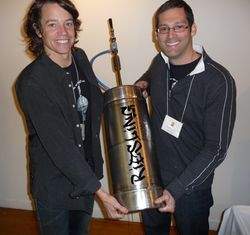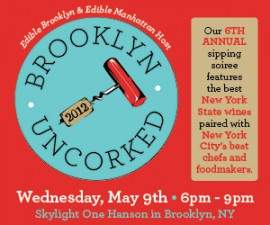Op-Ed: The Horrifying Trend That is “Wine on Tap” (Jim Silver, Peconic Bay Winery)
By James Silver, General Manager of Peconic Bay Winery, Nautique Wines and True Believer Cider
Photo courtesy of Dr. Vino
 I was recently asked by my distributor to put Peconic Bay wines into kegs for sale in Manhattan, to accounts you would no doubt recognize, who have embraced this curious new “wine on tap” (WOT) service system.
I was recently asked by my distributor to put Peconic Bay wines into kegs for sale in Manhattan, to accounts you would no doubt recognize, who have embraced this curious new “wine on tap” (WOT) service system.
I never recoil from a sale, but the idea of presenting our wines in this pedestrian manner immediately began to weigh on my sensibilities. The defense of WOT is so amorphous, and chanted with a religious zeal, while the drawbacks, in my mind seem so genuine to me. Let me remove the financials from the argument, since profit is relative here.
To the consumer, the whole idea of an “always fresh” wine must seem so appealing. I actually didn’t realize there was a freshness problem. Oh sure, I’ve been to any number of restaurants where the wine had been opened the night before or worse, but that doesn’t seem to be the problem of the conscientious restaurants we are talking about here.
And what could be fresher than a newly opened bottle? If you are concerned at all, ask the server to pour from a new bottle.
This brings us to the waste issue. There’s no waste in a keg — so I am told. Let us consider this, because I have no interest in drinking the wine that sits in the keg lines overnight or the first drop delivered from the tap nozzle where bacteria may grow overnight or even from the first wine passed through just cleaned keg lines.
What are they using to clean them, and what does that do to my glass of wine? Unless you are unwilling to pass a certain quantity of wine through the system to get the perfect first glass, I would call that potentially wasteful. Of course I may not know that I got the wine from the recently bleached keg lines, so I’ll just have to assume that I don’t like this wine.
And before anyone falls on my neck wailing that they keep their system perfectly clean and the lines are perfect and the product is perfect – I know. I’m not talking about you. I’m talking about the posers who don’t care as much as you do. They are out there.
I ran bars and restaurants for years in Philadelphia, and we always kept our taps and lines spotlessly clean - except when we couldn’t. But it’s too easy to exaggerate the potential effects the lines and taps may have on the character wine, so I’ll let it go, but suffice to say, the optimum service technique shouldn’t involve traveling through plastic lines for several yards under pressure and exiting from a difficult-to-clean brass nozzle. And if you thought you had a fruit-fly problem before, just wait…
What about being green? Shipping empty kegs of air from restaurant back to the winery, and the storage and cleaning of the kegs are all issues purportedly offset by the wasteful glass bottle, and the suddenly unnecessary cork and label. If it is a substantial reduction of the carbon footprint, I haven’t seen the reports on that, just assumptions, though logical ones.
In my opinion, if one wants to reduce their carbon footprint they could be buying 50% more local wine, let’s say from 300 miles away or less, and abandon anything not coming from this continent at the very least. But that’s just silly I imagine – silly in New York that is to say – not so silly any place else on the planet where local wine is often considered somewhat differently.
The mostly false arguments still made about the intimidation factor of wine, and wine service, are not the sort of problems you fix with a sledgehammer solution like doing away with the bottle and the cork. If your server struggles with a corkscrew you have deeper problems. If your customer struggles with the pronunciation of a producer’s name, removing his ability to choose is not doing him any favors. If this dangerous trend continues, we may also lament the loss of serving wines at different temperatures based on their character; and the loss of small lots meant to demonstrate a vineyard’s terroir; and the loss of aging a bottle in the cellar. How do we compare vintages or development over time? Do we care? What changes are being made to the finished wine to compensate for the potential spontaneous production of “reductive” characteristics in the keg?
What is worse than any of that is the marginalization of a winery’s future business.
If I enjoy a glass of wine from a keg, how am I supposed to purchase a bottle of it the next day? How can I expect it to taste the same if I actually am able? How do I create a memory when everything about my wine is presented verbally, or on a wine list, written or spoken by others? How do I create loyalty for my winery when the end-user gets his message from a chalkboard, and not from my label? How far removed are we from the generic at this point, and how far removed from the generic will we be when there are 25 taps, all pouring varietal wines – with nary a producer’s name, vintage, vineyard name, or appellation to be found? It could happen, and you know it can. It already did in the 70s when Inglenook, Almaden, Taylor and Gallo were sold in 18L kegs and your menu choices were Chablis, Burgundy and Rosé. Am I willing to be the generic house chardonnay tomorrow if that means my name isn’t out there on the product?
Today these taps are occupied by small producers of very fine wine, who I respect. And the taps are handled by the very top tier of restaurants and sommeliers. But tomorrow, who will come along and offer the restaurant a keg at half the price or less, full of Mendoza malbec or a Casablanca sauvignon blanc?
They might be from wineries whose purpose it is to fill kegs, not create memories or brand awareness. If today’s brilliant sommeliers continue to feed this well-intentioned monster, and the trend spreads to the majority of restaurants seeking to follow in this fashion, the consumer of 2021 will have very limited choices indeed, by the glass – or then again, all wineries will have to gear up for keg production if they hope to be by the glass ever again. The larger producers will naturally prevail again.
No one who has ever saved a bottle of wine for a special occasion, aged a Burgundy for a decade, cradled a prized and “precious” cabernet in their cellar, or recalled a fabulous party while looking at the empties on the counter could think this is a good idea. No one who loves small producers and artisan winemaking should.














